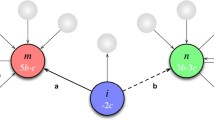Abstract
In this paper, we explore how decentralized local interactions of autonomous agents in a network relate to collective behaviors. Earlier work in this area has modeled social networks with fixed agent relations. We instead focus on dynamic social networks in which agents can rationally adjust their neighborhoods based on their individual interests. We propose a new connection evaluation theory, the Highest Weighted Reward (HWR) rule: agents dynamically choose their neighbors in order to maximize their own utilities based on rewards from previous interactions. We prove that, in the two-action pure coordination game, our system would stabilize to a clustering state in which all relationships in the network are rewarded with an optimal payoff. Our experiments verify this theory and also reveal additional interesting patterns in the network.











Similar content being viewed by others
Notes
For details, please check the original article at http://www.jesse-anderson.com/2011/08/a-few-more-million-amazonian-monkeys/.
References
Acemoglu D, Ozdaglar A, ParandehGheibi A (2010) Spread of (mis)information in social networks. Games Econ Behav 70:194–227
Axelrod RM (1997) The complexity of cooperation: agent-based models of competition and collaboration. Princeton University Press, Princeton
Banks D (2009) Dynamic network models: introduction to new and interdisciplinary approaches. Comput Math Organ Theory 15:259–260
Borenstein E, Ruppin E (2003) Enhancing autonomous agents evolution with learning by imitation. AISB J 1(4):335–348
Centola D (2009) Failure in complex social networks. J Math Sociol 3(3):64–68
Chen Y, Bressler SL, Ding M (2009) Dynamics on networks: assessing functional connectivity with Granger causality. Comput Math Organ Theory 15:329–350
Davidsson P (2002) Agent-based social simulation: a computer science view. J Artif Soc Soc Simul 5(1)
Delgado J (2002) Emergence of social conventions in complex networks. Artif Intell 171–185
Dignum F (1999) Autonomous agents with norms. AI Law 1–15
Dorogovtsev SN, Goltsev AV, Mendes JFF (2008) Critical phenomena in complex networks. Rev Mod Phys 80:1275
Ehrhardt G, Marsili M, Vega-Redondo F (2008) Emergence and resilience of social networks: a general theoretical framework. Ann Econ Stat 86
Epstein J (1999) Agent-based computational models and generative social science. Complexity 4(5)
Erve I, Roth AE (1998) Predicting how people play games: reinforcement learning in experimental games with unique mixed equilibria. Am Econ Rev 848–881
Fararo TJ, Sunshine MH (1964) A study of a biased friendship net. Syracuse Univ. Press, Syracuse
Flache A, Macy MW (2011) Small worlds and culture polarization. J Math Sociol 35(1):146–176
Frantz TL, Cataldo M, Carley KM (2009) Robustness of centrality measures under uncertainty: examining the role of network topology. Comput Math Organ Theory 15:303–328
Handcock MS, Morris M (2009) A curved exponential family model for complex networks. Comput Math Organ Theory 15:294–302
Hoff PD (2009) Multiplicative latent factor models for description and prediction of social networks. Comput Math Organ Theory 15:261–272
Jiang Y, Toru I (2007) A model for collective strategy diffusion in agent social law evolution. In: International joint conference on artificial intelligence
Jin E, Girvan M, Newman MEJ (2001) The structure of growing social networks. Phys Rev
Jones JD (2008) Heterogeneity of degree and the emergence of cooperation in complex social networks. Emergence 10(4):46–54
Kempe D, Kleinberg J, Tardos E (2003) Maximizing the spread of influence in a social network. In: Proceedings of KDD 2003, Washington, DC
Kittok JE (1995) Emergent conventions and the structure of multi-agent systems. In: Nadel L, Stein D (eds) Lectures in complex systems. Addison-Wesley, Reading
Lewis DK (1969) Convention: a philosophical study. Harvard Univ. Press, Cambridge
Liljeros F, Edling CR, Amaral LAN, Stanely HE, Aberg Y (2001) The web of human sexual contacts. Nature 907–908
Lopez-Pintado D (2008) Diffusion in complex social networks. Games Econ Behav 62:573–590
Molchanov S, Whitmeyer JM (2011) Two Markoc models of the spread of rumors. J Math Sociol 34(3):157–166
Newmann MEJ (2003) The structure and function of complex networks. Society for Industrial and Applied Mathematics, Philadelphia
Pujol JM, Flache A, Delgado J, Sangüesa R (2005a) How can social networks ever become complex? Modeling the emergence of complex networks from local social exchanges. J Artif Soc Soc Simul 8(4)
Pujol Jm, Delgado J, Sangüesa R, Flache A (2005b) The role of clustering on the emergence of efficient social conventions. In: International Joint Conference on Artificial Intelligence, pp 965–970
Redner S (1998) How popular is your paper? An empirical study of the citation distribution. Eur Phys 131–134
Shoham Y, Tennenholtz M (1997) On the emergence of social conventions: Modeling, analysis and simulations. AI 139–166
Skyrms B (2004) The stag hunt and evolution of social structure. Cambridge University Press, Cambridge
Turner A, Penn A (2002) Encoding natural movement as an agent-based system: an investigation into human pedestrian behaviour in the built environment. Environ Plan B, Plan Des 29:473–490
Vance EA, Archie EA, Moss CJ (2009) Social networks in African elephants. Comput Math Organ Theory 15:303–328
Walker A, Wooldridge M (1995) Understanding the emergence of conventions in multi-agent systems. In: Lesser V (ed) Proc. 1st international conference on multi-agent systems. AAAI Press, Menlo Park, pp 384–389
Watts DJ (1999) Small worlds. Princeton University Press, Princeton
Younger S (2004) Reciprocity, normative reputation, and the development of mutual obligation in gift giving societies. J Artif Soc Soc Simul
Zimmermann M, Eguiluz V (2005) Cooperation, social networks and the emergence of leadership in a prisoners dilemma with adaptive local interactions. Phys Rev
Zhang Y, Leezer J (2009) Emergence of social norms in complex networks. In: Symposium on social computing applications (SCA09), The 2009 IEEE international conference on social computing (SocialCom-09), Vancouver, Canada, 29–31 August 2009, pp 549–555
Acknowledgements
This work was supported in part by the U.S. National Science Foundation under Grants IIS 0755405 and CNS 0821585. We would also like to thank Sophia Goreczky and KangChon Kim for their contributions to the experiment.
Author information
Authors and Affiliations
Corresponding author
Rights and permissions
About this article
Cite this article
Zhang, Y., Wu, Y. How behaviors spread in dynamic social networks. Comput Math Organ Theory 18, 419–444 (2012). https://doi.org/10.1007/s10588-011-9105-7
Published:
Issue Date:
DOI: https://doi.org/10.1007/s10588-011-9105-7




